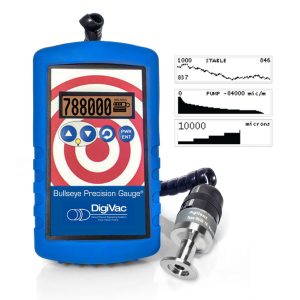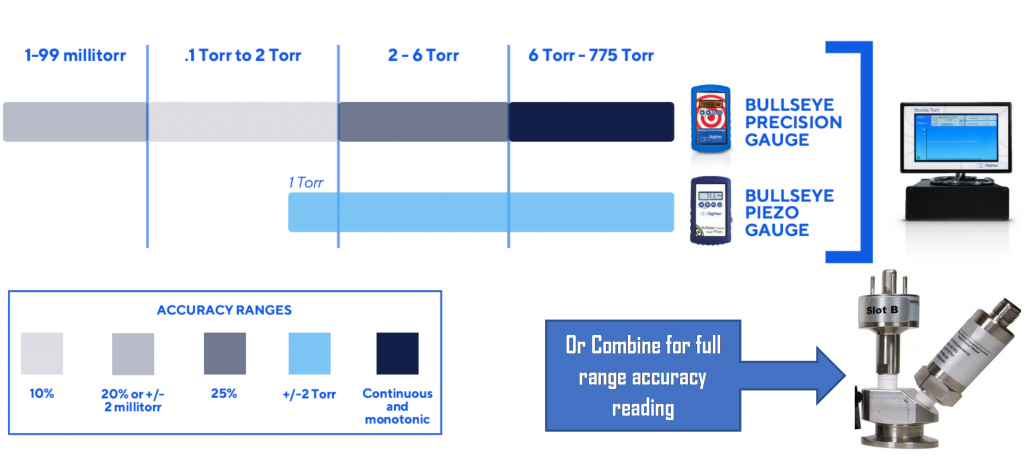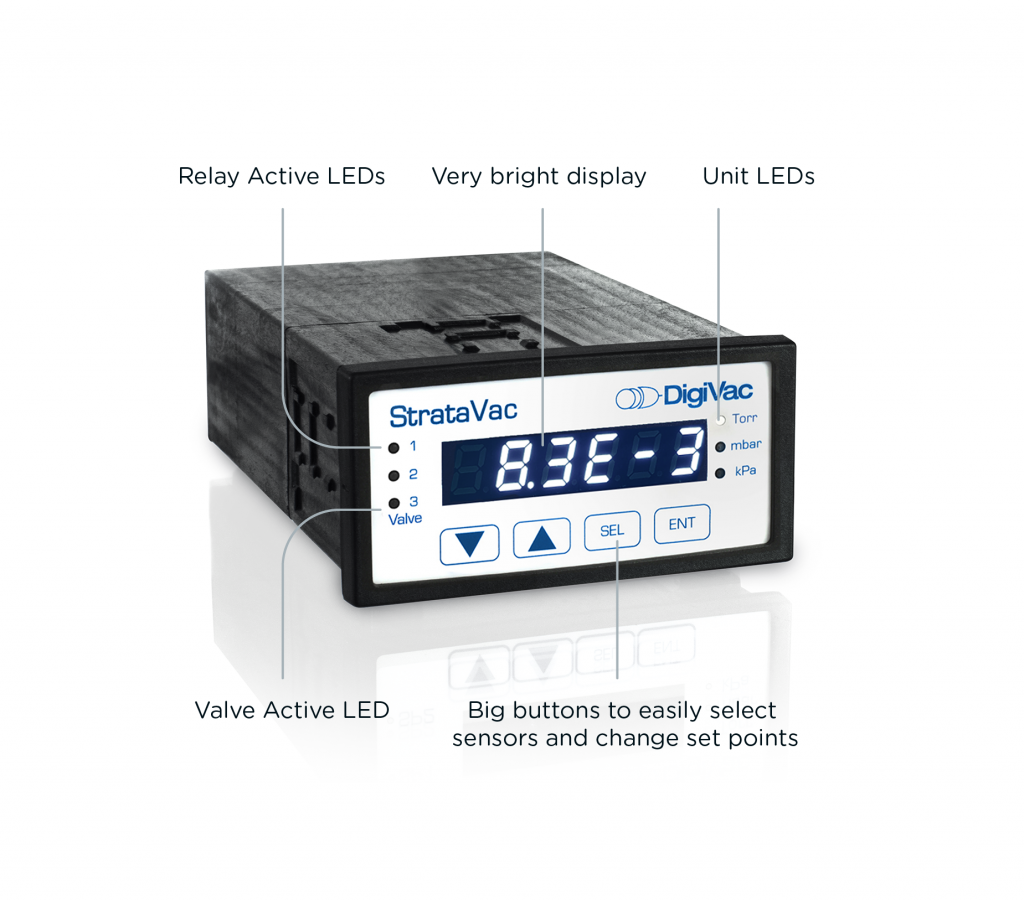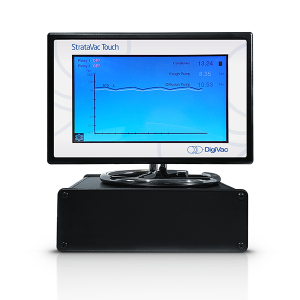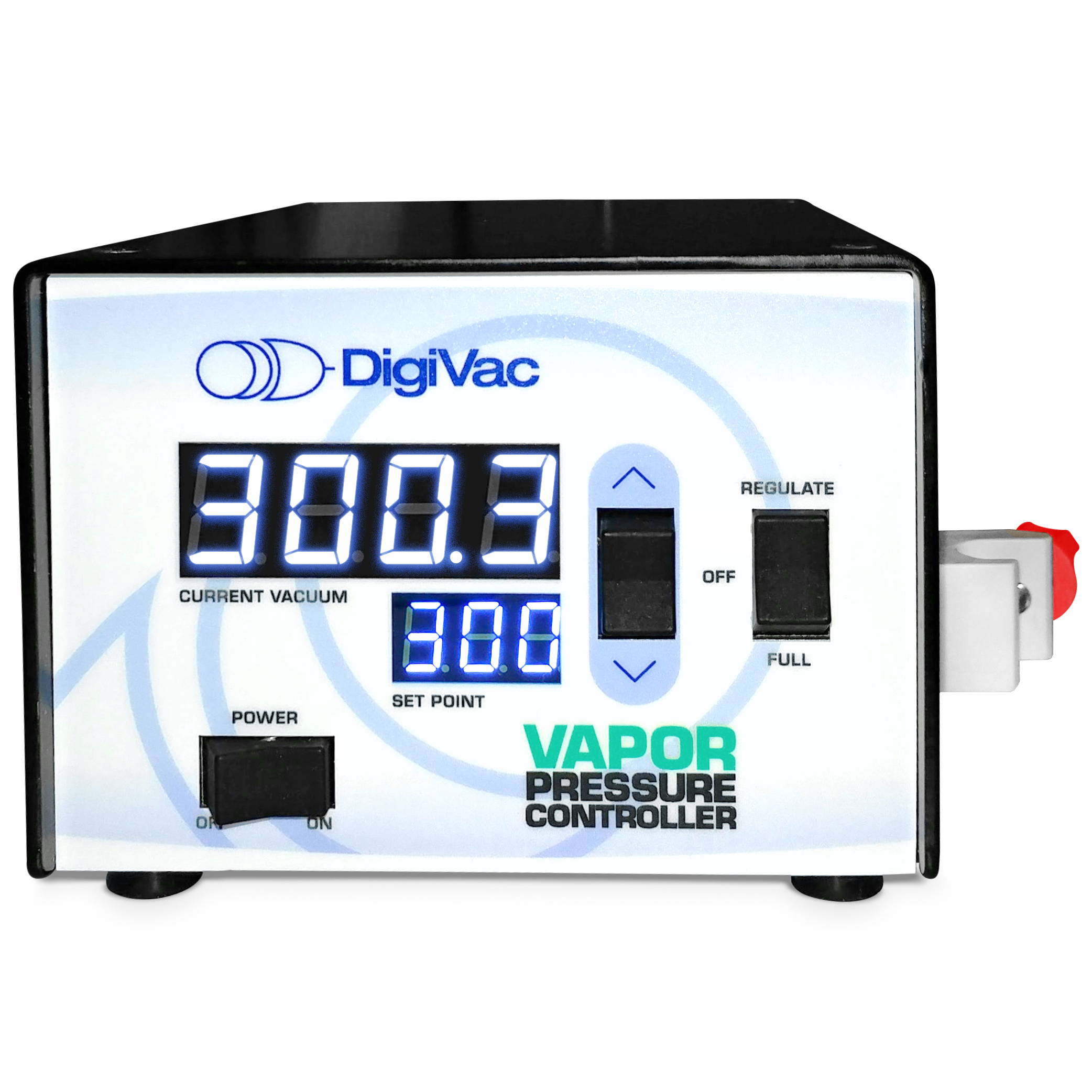Physics of vacuum gauge sensors and manometers
If you haven’t been in the vacuum industry for many years, you might want to consider browsing wikipedia or another source on some of the basic types of pressure and vacuum measurement. DigiVac uses a variety of its own sensors, as well as sensors from a third party. DigiVac has perfected the use of thermocouple vacuum gauge tubes, which is similar to a Pirani gauge in theory.
Terminology used by vacuum vendors
The most important thing that any vendor can offer you is the ability to solve your vacuum measurement or process control challenge in a quick, efficient and cost effective manner. Therefore, it’s important to understand industry standard terminology.
What is a Vacuum Gauge?
A Vacuum gauge is a device that measures the pressure, or that pressure below atmosphere.
DigiVac uses this term to refer to the product that you buy that includes all of the components needed to measure vacuum.
This includes a vacuum sensor as a mated pair that is calibrated under vacuum to a NIST standard so the accuracy of the gauge is at its best. In this example, DigiVac’s patented Bullseye Precision Gauge is paired with a thermocouple vacuum gauge tube. See our gauge and controller accuracy specifications here.
Sometimes vendors may refer to the transducer (such is the case with some capacitance manometer vendors) as a “vacuum gauge.” And use the terminology “vacuum gauge controller” as the device that powers and reads the vacuum gauge. We just think it is a little less confusing to use the term vacuum gauge for the combination of the tube and device the that provides the useful information to the end user.
What is the Range of Accuracy for your application?
DigiVac offers a range of Vacuum Gauges and Controllers that will serve industries that work in rough vacuum (served by our Thermocouple gauges) to pressures 1×10-9 to 1000 mbar that may be used in research and development.
What is Piezo-resistive technology?
Piezoresistive materials are materials that change resistance to the flow of current when they are compressed or strained. Metal is piezoresistive to some degree, but most pressure sensors use the semiconductor silicon.
When force is put on the silicon, it becomes more resistant to a current pushing through. This resistance is usually very linear | twice as much pressure results in twice as large a change in resistance.
A Piezoresistive Pressure Sensor contains several thin wafers of silicon embedded between protective surfaces. The surface is usually connected to a Wheatstone bridge, a device for detecting small differences in resistance.
The Wheatstone bridge runs a small amount of current through the sensor. When the resistance changes, less current passes through the pressure sensor. The Wheatstone bridge detects this change and reports a change in pressure.
Unlike thermal sensors, Piezo sensors are NOT gas dependent.
What are Thermocouple Vacuum gauge tubes?
A thermocouple vacuum gauge tube is a transducer that senses vacuum by leveraging the principal of seeing how a wire changes temperature as vacuum is changed. Common designs of thermocouple gauge tubes are Varian/Agilent, Frederics, Hastings and Thermocouple Plus (VGT-500), to name a few.
How does Thermocouple technology work?
Thermocouple sensors (thermal conductivity gauges) rely on the fact that the ability of a gas to conduct heat decreases with pressure. In this type of gauge, a wire filament is heated by running current through it. A thermocouple or Resistance Temperature Detector (RTD) can then be used to measure the temperature of the filament.
This temperature is dependent on the rate at which the filament loses heat to the surrounding gas, and therefore on the thermal conductivity. A common variant is the Pirani gauge which uses a single platinum filament as both the heated element and RTD.
Importantly, thermal sensors are gas dependent. Thermocouple vacuum sensors are calibrated for nitrogen or air, but conversion factors for other gases are available. See scientific application note here on a thermal pirani sensor.
How do Capacitance Manometers work?
A capacitance manometer (CM) contains the diaphragm and the metal-on-ceramic electrode structure. The reference side (backside) of the diaphragm is evacuated to a very high vacuum, much lower than the pressures that are to be measured.
The high vacuum on the reference side is maintained over the life of the manometer by means of an internal chemical getter pump. The sensors are made of all-welded construction for ruggedness and compatibility with process environments.
Pressure is determined by measuring the change in capacitance between the metal diaphragm and an adjacent, fixed dual 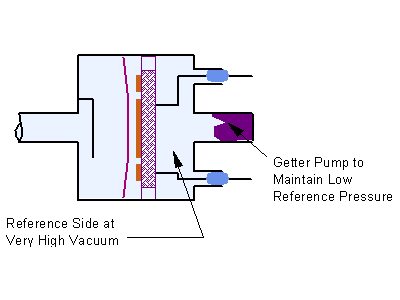 electrode.
electrode.
The radially tensioned diaphragm provides very low hysteresis, excellent repeatability, remarkably high resolution (1 x 10-5 of Full Scale), fast response, and the ability to measure extremely low pressures.
If a high over-pressure is applied to the manometer, the diaphragm will bottom out on the electrode substrate, preventing permanent damage to the sensor. Accuracy ranges are usually around 1% of reading.
What is a vacuum controller?
A vacuum controller both measures and controls vacuum. The device translates the vacuum data from the vacuum transducer, the thermocouple vacuum gauge tube or other transducer to a meaningful output.
Vacuum process control can be done by either placing upper and lower set-points to keep your process within a specific range or by more advanced control options with the inclusion of precision isolation valves that allows things like time versus pressure or vacuum RAMP control to be implemented.
In the manufacturing industry, it is common practice to manually turn valves to achieve a ramp rate that ensures the material of interest is not lost. Consistent process control is critical. Manual valve operation can leave a human margin of error that is not acceptable in many industries since it can be very difficult to do accurately in medium or high vacuum situations. DigiVac has a range of vacuum controller and innovative valve designs to streamline this process.
For example, DigiVac makes Vacuum gauge controllers for capacitance manometers, piezoresistive sensors, thermocouple and other types of vacuum sensing tubes or transducers.
What are the different vacuum controller options?
A vacuum controller is a device that holds the vacuum of a system at a particular vacuum set point. Often this is achieved manually by a person connecting a vacuum gauge to a system, and manually cracking a vacuum valve open to achieve the desired vacuum.
A vacuum level controller device like the DigiVac Model 450 can achieve this in the Torr range with far less human intervention.
StrataVac Controller
The DigiVac STRATAVAC is a digital vacuum control instrument highly configurable and capable of driving multiple types of sensors (active, passive, and capacitance manometers).
– Application Versatility: The DigiVac StrataVac Product Line has many applications from simple passive sensor monitoring to combining multiple sensors in order to create a wide range calibration standard that controls vacuum pump down.
– Modular Customization: It uses a modular building block approach to build the most efficient configuration to achieve a task.
StrataVac Touch Controller
The StrataVac Touch is a premium vacuum controller with touchscreen display that allows you to monitor and/or control multiple areas of your vacuum system. It can be configured to cover a wide range of vacuum pressures from rough to high vacuum.
– Easily see a snapshot of up to 4 of your sensors and up to 3 valves across your vacuum system
– Can control vacuum through a wide range using a bleed or throttle valves
– Combine 2 or 3 capacitance manometers into one reading to expand the range for direct measurement up to 7.5 decades
– Wide Range Accuracy—Configured with sensors based on the accuracy and range required to sense vacuum and display the pressure reading. User can select units of Torr, mbar, kilopascal (kPa), millitorr, or microns
– Covers from Rough to High Vacuum when paired with compatible sensor Thermocouple, convection 275, capacitance manometer, piezo, cold cathode/pirani combination gauge
– Control: Choose Bleed and/or Throttle Control. If 2 valves are chosen, both can be controlled by readings from 1 sensor or each valve can be controlled by different sensors
– Calibrated—Every STRATAVAC is calibrated and pretested under actual vacuum against a NIST standard
– NIST Certified documentation with before and after data included is a separate option that can be added to your order by adding this option to your order
Vapor Pressure Controller (VPC)
Vapor pressure or equilibrium vapor pressure is defined as the pressure exerted by a vapor in thermodynamic equilibrium with its condensed phases (solid or liquid) at a given temperature in a closed system. The equilibrium vapor pressure is an indication of a liquid’s evaporation rate. It relates to the tendency of particles to escape from the liquid (or a solid). A substance with a high vapor pressure at normal temperatures is often referred to as volatile.
The pressure exhibited by vapor present above a liquid surface is known as vapor pressure. As the temperature of a liquid increases, the kinetic energy of its molecules also increases. As the kinetic energy of the molecules increases, the number of molecules transitioning into a vapor also increases, thereby increasing the vapor pressure.
As a general trend, vapor pressures of liquids at ambient temperatures increase with decreasing boiling points. Accurate vapor pressure control is important in processing since a the addition of vacuum pressure control allows you to process at a lower temperature, which helps keep expensive process material from oxidizing, degrading, or being lost.
The DigiVac Vapor Pressure Controller allows you to determine set-points and maintain vacuum at that level. The pressure controller is particularly useful when you are looking to maintain pressure at a certain level as needed for botanical processing and rotary evaporation.
VPC Unique Features
– Fine Grained Vacuum Control
– Simultaneous display of both current vacuum and set point
– Direct one touch set point setting
– Remote control via USB
Benefits
– Fine control of target vapor pressure for more precise compound separation through distillation
– Keeps your pump oil away from your process
– Enables using reliable and long lasting rotary vane oil pumps in applications where diaphragm pumps were previously required
– Keeps vacuum pumps near their base pressure resulting in longevity, fewer oil changes and less oil mist

